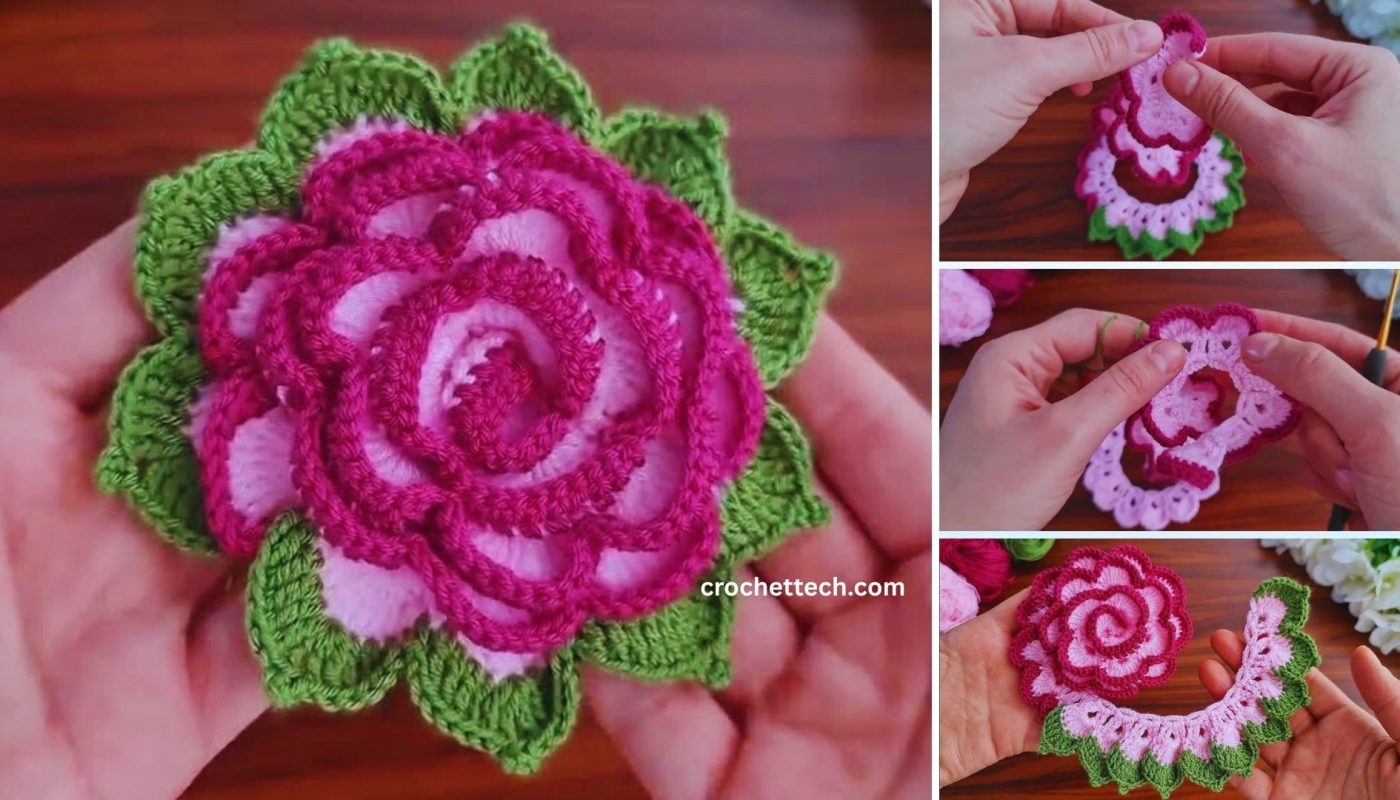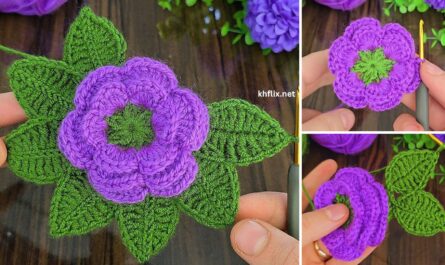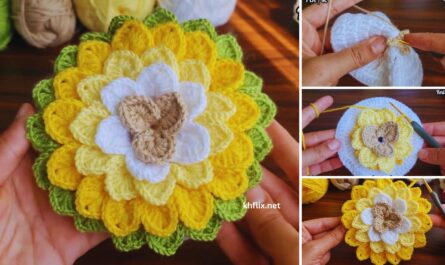Let’s crochet a truly beautiful and vibrant three-color crochet rose flower! As a beginner, tackling a multi-color project might seem daunting, but this detailed guide will break it down into easy, manageable steps. By strategically placing colors, we’ll create a rose that looks complex and stunning, but is surprisingly achievable with basic stitches.
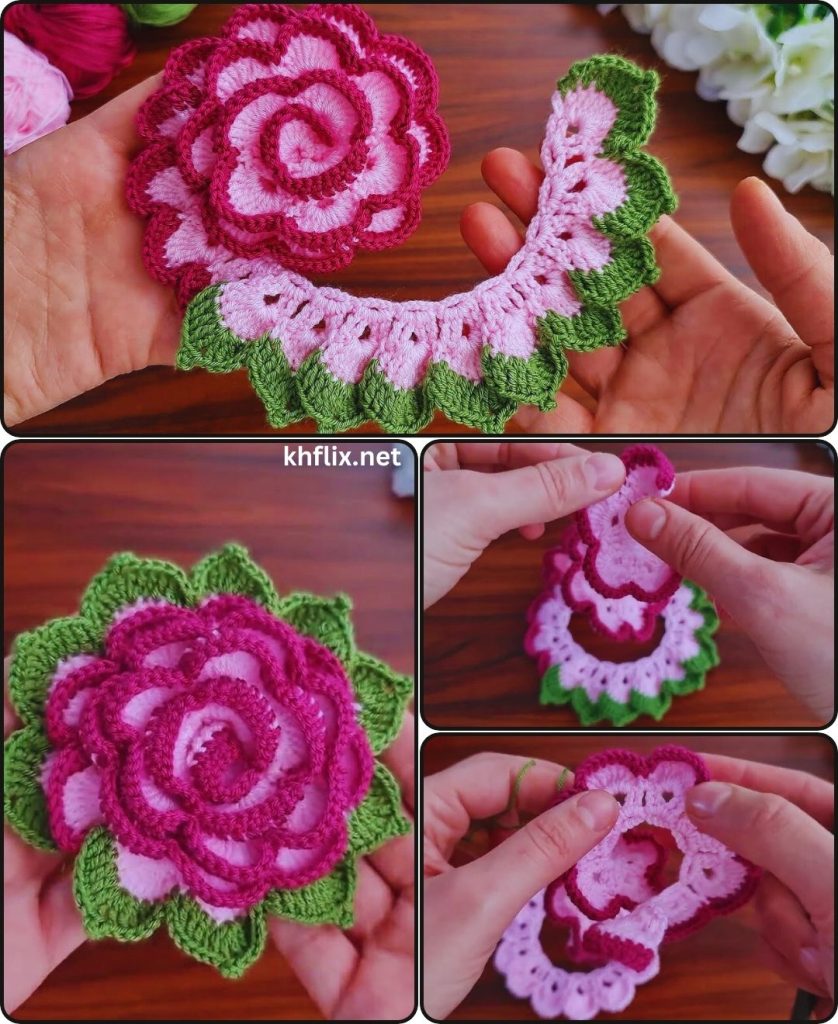
How to Crochet a Beautiful Rose Flower with Three Colors: A Detailed Beginner’s Guide
This comprehensive tutorial will guide you through crafting an eye-catching, multi-layered crochet rose using three different colors. We’ll utilize simple stitches and a clever construction method, allowing even beginners to achieve a professional-looking, realistic bloom that’s perfect for embellishing blankets, hats, bags, or as a charming standalone decoration.
Skill Level: Beginner
This project is perfectly suited for you if you’re comfortable with (or ready to learn!):
- Holding your hook and yarn: The fundamental grip.
- Making a slip knot: The starting point for most crochet projects.
- Chain (ch): The most basic stitch, forming your foundation.
- Slip Stitch (sl st): Used for joining rows and neatening ends.
- Single Crochet (sc): A short, dense stitch, great for sturdy fabric.
- Half Double Crochet (hdc): An intermediate stitch, taller than sc and works up quickly.
- Double Crochet (dc): A taller stitch, creating a more open and flexible fabric.
- Working in rows: Crocheting back and forth across your work.
- Changing colors: The fun part that adds vibrancy!
- Weaving in ends: The essential finishing touch for a clean look.
Finished Rose Dimensions (Approximate):
Using worsted weight yarn and the suggested hook, your finished three-color rose will typically be about 3 to 4.5 inches (7.5 to 11.5 cm) in diameter and 1.5 to 2 inches (4 to 5 cm) tall. The exact size will vary slightly depending on your personal tension and how snugly you roll your rose.
Materials You’ll Need:
Gathering your materials before you start makes the process smoother and more enjoyable.
- Yarn: Small amounts of Worsted Weight (Medium #4) Yarn in three distinct colors.
- Color A (Inner Petals/Core): Approximately 10-15 yards (9-14 meters). This will be the color of the tightest, innermost part of your rose. Think light pink, cream, or a pale yellow for the core.
- Color B (Mid-Petals): Approximately 15-20 yards (14-18 meters). This will be the next layer of petals. Choose a color that complements or is a slightly darker shade of Color A (e.g., medium pink, peach, light orange).
- Color C (Outer Petals): Approximately 20-25 yards (18-23 meters). This will be the most prominent, outermost layer of petals. Pick a bold or rich color (e.g., deep red, fuchsia, bright yellow, or a contrasting purple).
- Yarn Type: Acrylic yarn is highly recommended for beginners. It’s smooth, inexpensive, widely available, and easy to work with. It also holds its shape well after rolling.
- Crochet Hook: Size H/5.0mm. This hook size is a versatile choice for worsted weight yarn. It creates a fabric that’s dense enough to hold the rose’s shape but still flexible enough to roll and form beautiful petals.
- Yarn Needle (Tapestry Needle): This is absolutely essential for the final step of sewing your rose together and weaving in all your color changes. It has a blunt tip and a large eye.
- Scissors: Any pair of sharp scissors will do for cutting your yarn.
Understanding the Rose Construction: The Magic of Color and Layers
The beauty of this three-color rose pattern lies in its clever construction. Like a natural rose, it’s built from a central core outwards, with each layer of petals gradually increasing in size and, in our case, changing color.
We’ll create one long, flat strip of crochet. This strip is designed with sections of increasing stitch height, and we’ll introduce a new color for each section. When you roll this strip, the taller, newer color sections naturally flare out, forming the vibrant, multi-layered petals, while the shorter, earlier color sections create the tighter inner bud.
The construction process involves three main stages:
- Foundation Chain: This is your starting point, forming the initial length of your rose strip.
- Petal Strip with Color Changes: You’ll work rows of gradually increasing stitch heights (from single crochet to half double crochet to double crochet). A new color is introduced at the start of each row (or section of rows) that defines a new petal layer.
- Rolling and Sewing: The finished crocheted strip is gently rolled into its iconic spiral shape and then securely stitched at the base to hold it all together.
Let’s Crochet Your Beautiful Three-Color Rose!
Follow these steps carefully. The key is to pay attention to your stitch counts and when to change colors. Don’t be afraid to take your time!
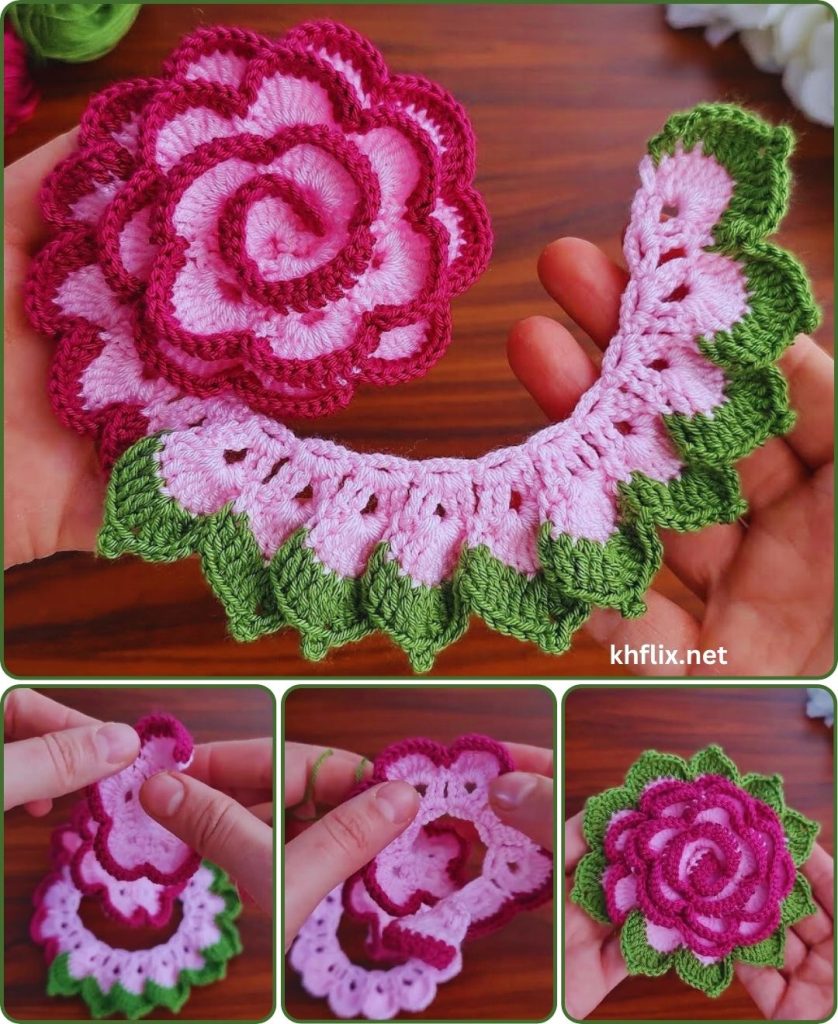
Part 1: Crocheting the Petal Strip with Color Changes
This long strip, with its integrated color changes, will be transformed into your beautiful three-color rose. The length of your initial chain directly influences how large and full your finished rose will be.
- Starting Chain (Color A):
- Begin by making a slip knot with Color A and placing it onto your H/5.0mm crochet hook.
- Chain (ch) 40. This is a good length for a medium-to-large multi-color rose.
- Want a slightly smaller rose? Chain 30-35.
- Dreaming of an even larger, fuller rose? Chain 50-60.
- Count your chains carefully!
- Row 1 (Foundation Row – Single Crochet – Color A):
- We’ll start by making a row of single crochet (sc) stitches into your chain. This creates a sturdy, dense base for your petals.
- Insert your hook into the 2nd chain from your hook.
- Yarn over (wrap the yarn from back to front over your hook).
- Pull the yarn through the chain stitch (you now have 2 loops on your hook).
- Yarn over again.
- Pull the yarn through both loops on your hook. You’ve made your first single crochet (sc)!
- Continue to work 1 sc into each remaining chain across the entire row. You should end up with a total of 39 single crochet stitches.
- Do NOT chain 1 and turn yet. We’ll change color.
- Changing Color to Color B:
- To change color neatly, do it on the last stitch of the previous row.
- Work the very last single crochet stitch of Row 1 almost completely: Insert hook into the last sc, yarn over, pull up a loop (2 loops on hook).
- Now, drop Color A. Pick up Color B.
- With Color B, yarn over and pull through both loops on your hook to complete the sc stitch. Color A is now dropped, and Color B is on your hook.
- Chain 1 (ch 1) with Color B. This chain 1 acts as your turning chain.
- Turn your work.
- Row 2 (Inner Petals – Single Crochet & Chain 1 – Color B):
- This row (and the next) will use Color B to create the inner layer of petals.
- Work (1 sc, ch 1) into the first single crochet stitch of the previous row (the stitch you just completed with Color B).
- Now, skip the next single crochet stitch.
- Work (1 sc, ch 1) into the single crochet stitch after the one you skipped.
- Repeat this pattern: * Skip 1 sc. Work (1 sc, ch 1) into the next sc. *
- Continue repeating from * to * across the entire row. You’ll end up with approximately 20 (sc, ch 1) pairs.
- Do NOT chain to turn yet. We’ll change color again.
- Changing Color to Color C:
- Work the very last (sc, ch 1) pair of Row 2 almost completely. Make the final ch 1 of the pair.
- Now, drop Color B. Pick up Color C.
- With Color C, chain 2 (ch 2). This chain 2 will give you the necessary height for the next row and counts as the first half double crochet (hdc) of the next row.
- Turn your work.
- Row 3 (Mid-Petals – Half Double Crochet & Chain 1 – Color C):
- This row will use Color C to create the mid-sized petals, adding more fullness and a new color to your rose.
- You’ll be working into the chain 1 spaces from the previous row (Row 2).
- Work (2 half double crochet (hdc), ch 1) into the first chain 1 space from the previous row. (Make two hdc stitches, then ch 1, all into the first ch 1 space.)
- *Work (2 hdc, ch 1) into the next chain 1 space.*
- Repeat from * to * across the entire row.
- You’ll have 20 (2hdc, ch 1) groups.
- Do NOT chain to turn yet.
- Row 4 (Outer Petals – Double Crochet & Chain 1 – Color C):
- We’ll continue with Color C for this final, tallest layer of petals, making your rose truly stand out.
- Work (3 double crochet (dc), ch 1) into the first chain 1 space from the previous row (Row 3). (Make three dc stitches, then ch 1, all into the first ch 1 space.)
- *Work (3 dc, ch 1) into the next chain 1 space.*
- Repeat from * to * across the entire row.
- You’ll have 20 (3dc, ch 1) groups.
- Fasten off your yarn (Color C). Cut the yarn, leaving a very long tail (at least 24-30 inches / 60-75 cm is ideal). Pull this long tail completely through the loop left on your hook and gently tug to secure the knot. This long tail is absolutely critical for sewing your rose together!
Part 2: Rolling and Shaping Your Three-Color Rose
This is the magical part where your colorful flat strip transforms into a beautiful 3D flower! Take your time and enjoy the process.
- Identify the Smallest End: Look at your crocheted strip. The end that started with Color A (the single crochet row) will be the smallest and flattest. This is the end where you’ll begin rolling, as it will form the tight center bud of your rose. The other end, with the taller Color C double crochet stitches, will be the outermost, most vibrant petals.
- Start the Roll:
- Take the end with the smallest, Color A petals.
- Begin to roll this end tightly inwards a few times with your fingers, forming a small, snug cylinder. This forms the very core of your rose, showing off Color A.
- Continue Rolling and Shaping:
- As you continue to roll the rest of the strip, begin to slightly angle it downwards and outwards. This is the key to creating the natural spiral effect. The taller sections (Color B hdc rows and Color C dc rows) will naturally begin to flare out more and create layers around the inner core.
- Let the crocheted fabric and the petals overlap naturally as you roll. Don’t pull too tightly on the rolling; allow the petals to sit somewhat loosely and gracefully, mimicking the way real rose petals unfurl. Guide them with your fingers to ensure they form a pleasing, continuous spiral, showcasing all three colors.
- Keep rolling until you’ve used the entire strip and your rose has taken its final shape.
- Secure with Pins (Optional but Highly Recommended):
- Once you’ve rolled the entire strip into your desired rose shape, it’s very helpful to use a few sewing pins (dressmaker pins) to temporarily hold the base of the rose together. Stick the pins through the layers at the bottom to keep them from unraveling while you prepare to sew. This makes the next step much easier.
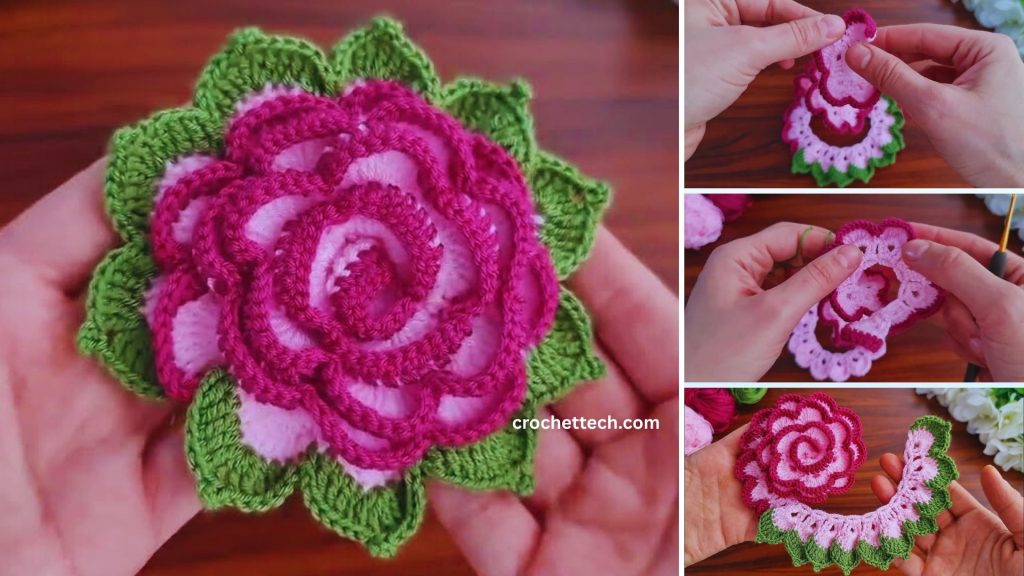
Part 3: Sewing the Rose Together
This is the crucial step that will make your beautiful, multi-colored rose permanent and hold its shape. This is why that long Color C tail is so important!
- Thread Your Needle:
- Thread the very long Color C tail you left from Row 4 onto your yarn needle.
- Sew the Base Thoroughly:
- Starting from the very center of the rose’s base (the underside of the rolled flower), pass your yarn needle repeatedly through all layers of the rolled fabric. Imagine you’re stitching back and forth across the “bottom” or “back” of the rose.
- Be meticulous and thorough: Make multiple stitches, going from one side of the base to the other, ensuring you catch every single layer of the rolled strip with your needle. This is vital to secure the spiral and prevent it from unraveling over time.
- Aim to create strong, tight stitches at the base that are not visible from the front (top) of the rose.
- Work your way back and forth across the entire base several times until it feels very sturdy and completely secure. Don’t skimp on this step!
- As you sew, you can gently adjust and shape the petals with your fingers, fluffing them out slightly if desired to enhance the 3D effect and showcase all three colors.
- Final Secure:
- Once the base feels absolutely solid and secure, weave in any remaining yarn tail (the long Color C one) into the base of the rose. Pass the needle through the stitches on the underside of the rose several times, going in different directions, to hide the tail completely and ensure it won’t come undone.
- Trim any excess yarn close to the fabric, being careful not to cut any of your rose stitches.
Final Touches:
- Weave in All Remaining Ends:
- You’ll have several short tails from where you changed colors (from Color A and Color B). Use your yarn needle to meticulously weave these tails into the stitches of the same color as the tail. This makes them practically invisible. Weave in one direction for about 1 inch, then subtly change direction and weave back through a few stitches. Trim any excess close to the fabric.
- Gently Shape and Admire:
- With your fingers, gently fluff and adjust the petals to achieve your desired rose shape. You can subtly curl individual petals outwards or inwards to create a more organic and natural look, ensuring all three colors are visible and beautiful.
- Step back and admire your stunning, handmade three-color crochet rose!
Congratulations! You’ve just crocheted a truly beautiful and vibrant three-color rose flower! This impressive bloom is a testament to your growing crochet skills and your ability to work with multiple colors. It’s ready to add a touch of unique handmade elegance to any project or simply brighten a space as a lovely decorative piece.
What creative project are you excited to use your new three-color rose on?

